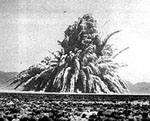Introduction
After the first use of atomic weapons in World War II there was an effort
by scientists and the government to find more constructive uses for nuclear
explosions. In 1953 President Eisenhower gave a speech to the UN
where he declared that the destructive power of atomic energy could be
put to use for the good of mankind. This is known as the “Atoms for
Peace” speech. Two of the more interesting projects that were considered
in this era were Project Orion and Project Chariot. Neither of these
projects were realized. They are interesting not only technically
but also for the environmental social and political issues that they raised.
Project Orion was a plan for a massive spaceship powered by atomic bombs. The spaceship would have been capable of transporting far larger payloads faster and farther than the chemical rockets of the time. One extreme version of ship was the size of Chicago and would have been powered by hydrogen bombs. The scientists working on it saw the project as a realistic way to explore and colonize space.
Project Chariot was part of Project Plowshare, an Atomic Energy Commission plan to use nuclear weapons for massive civil engineering projects. Edward Teller referred to the concept as geographic engineering. Project Chariot was a plan to use several atomic explosions to excavate a deepwater harbor in NW Alaska. The project was of doubtful economic value and would have been environmentally and culturally devastating to northern Alaska. A small group of Native Alaskans, scientists and grassroots activities opposed the plan.
Project Orion was a plan for a massive spaceship powered by atomic bombs. The spaceship would have been capable of transporting far larger payloads faster and farther than the chemical rockets of the time. One extreme version of ship was the size of Chicago and would have been powered by hydrogen bombs. The scientists working on it saw the project as a realistic way to explore and colonize space.
Project Chariot was part of Project Plowshare, an Atomic Energy Commission plan to use nuclear weapons for massive civil engineering projects. Edward Teller referred to the concept as geographic engineering. Project Chariot was a plan to use several atomic explosions to excavate a deepwater harbor in NW Alaska. The project was of doubtful economic value and would have been environmentally and culturally devastating to northern Alaska. A small group of Native Alaskans, scientists and grassroots activities opposed the plan.
